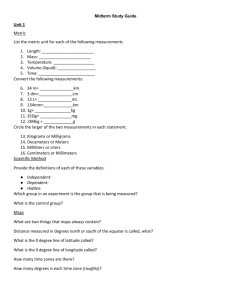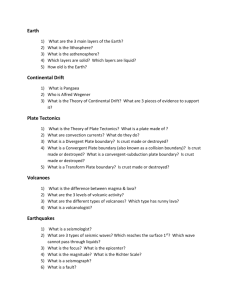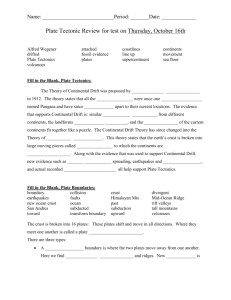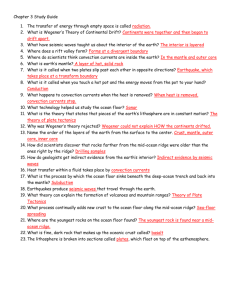Inside Earth Core Assessment Study Guide
advertisement
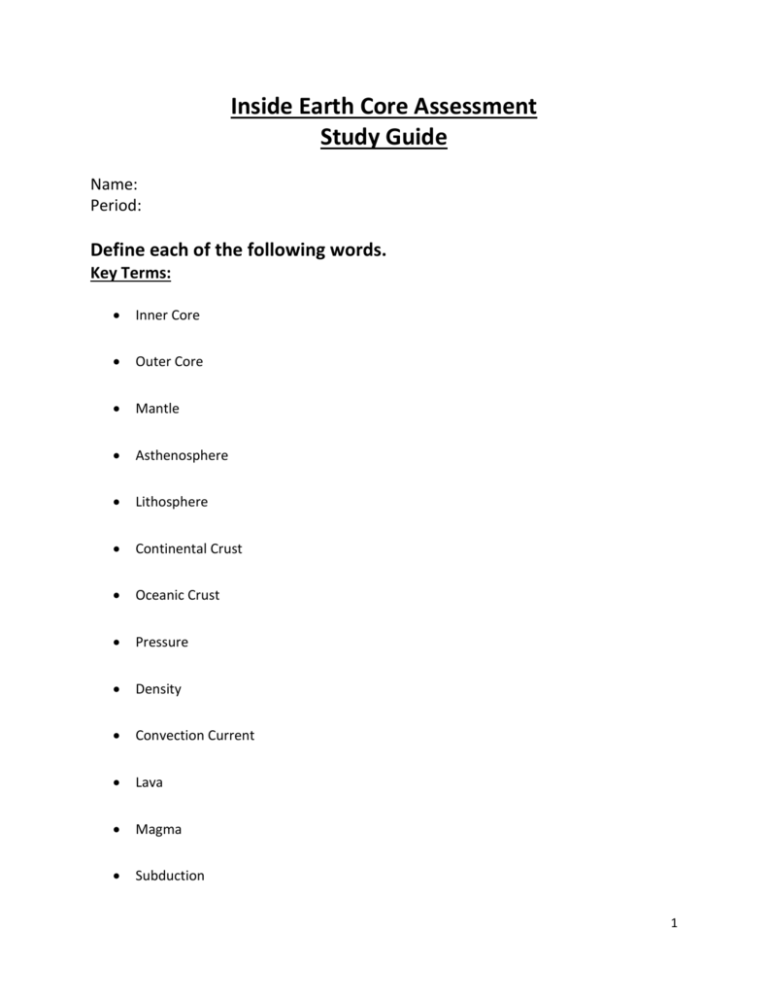
Inside Earth Core Assessment Study Guide Name: Period: Define each of the following words. Key Terms: Inner Core Outer Core Mantle Asthenosphere Lithosphere Continental Crust Oceanic Crust Pressure Density Convection Current Lava Magma Subduction 1 Seafloor Spreading Trench Mid-Ocean Ridge Rift Valley Fossil- Glossopteris Continental Drift Theory Continental Plates Convergent Boundary Divergent Boundary Transform Boundary Seismic Waves Earthquake P Wave S Wave Surface Wave Viscosity Silica 2 Hot Spot Cinder Cone Volcano Shield Volcano Composite Volcano Quiet Eruption Explosive Eruption Ring of Fire Rock Cycle Sedimentary Rock Metamorphic Rock Igneous Rock Sediment Deposition 3 Chapter 1 1. Explain what would happen to the following as you move from the crust to the inner core: temperature, pressure, and the state of matter as you went. a) Temperature: b) Pressure: c) State of Matter: 2) Use the diagram of the convection current to answer the following questions. a) Identify the heat source for the convection current in the illustration. b) Explain why heated magma rises, and cold magma sinks. 4 c) In which layer of Earth do convection currents occur? d) What material is being moved by the convection current? e) What would happen to the above current if the heat source was removed? f) Explain 2 major events that most geologists think the convention currents in the mantle cause on Earth? 1. Using the diagram below, describe three types of evidence Wegener used to support his Theory of Continental Drift? a. b. c. 5 2. Subduction relates to convection currents and the size of the Earth. a. Does this process add or remove crust? b. Which plate is subducting and why? 3. Explain what is happening during sea-floor spreading AND where does it happen? 4. Plate Boundaries: Complete the chart below. Name of Boundary Movement (use arrows) What it forms 6 5. Use the diagram above to answer the following questions. a. What type of plate boundary is show at Y? b. What land feature can be found at Y? c. What type of plate boundary is show at X? d. What land features can be found at X? e. What process is occuring at Z? f. Why is the oceanic crust subducting at Z and not the continental crust? g. Place a star on the diagram to show where the youngest oceanic rock would be found. 7 6. Use the reading and diagram of the amber fossil below to answer the following questions. Preserved in Amber: Sap is a substance secreted by some trees. Many years ago, plants and small animals were caught in the sap on the trees. Sap hardens and turns into a clear substance called amber. The plants or animals are preserved as fossils in the amber. Part of a plant preserved in amber is shown below. a) Explain how fossils were used as evidence that Pangaea existed. Chapter 2 7. Complete the table below on Seismic Waves. Type of Seismic Wave How the Seismic Wave Moves Materials Seismic Wave can move through 8 8. The bold line on the map below shows the San Andreas Fault. a) What type of plate boundary is shown above? b) What will the result be at this fault line? Chapter 3 9. Complete the table below on magma characteristics. Magma Type Temperature (High or Low) Viscosity (High or Low) Silica Type of Content Volcanic Eruption (High or Low) (Explosive/Quiet) Pahoehoe Aa 9 10. Use the map below to identify the highlighted portion. a) Name the area where most earthquakes and volcanoes occur. 11. Use the map below to answer the following questions. a) Why do most volcanoes occur along the Pacific plate? b) Explain why the Hawaiian volcanic islands are found in the middle of the Pacific plate. 10 Chapter 5.6 12. Use the rock cycle image to complete the table below. Rock Type Method of Formation melting and solidification deposition, compaction, and cementation Metamorphic 11 12
